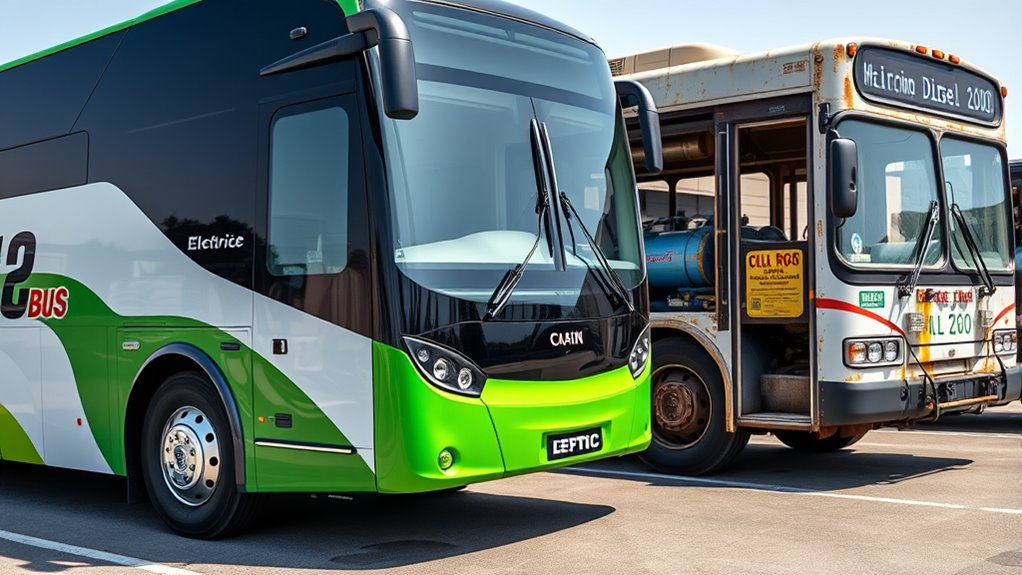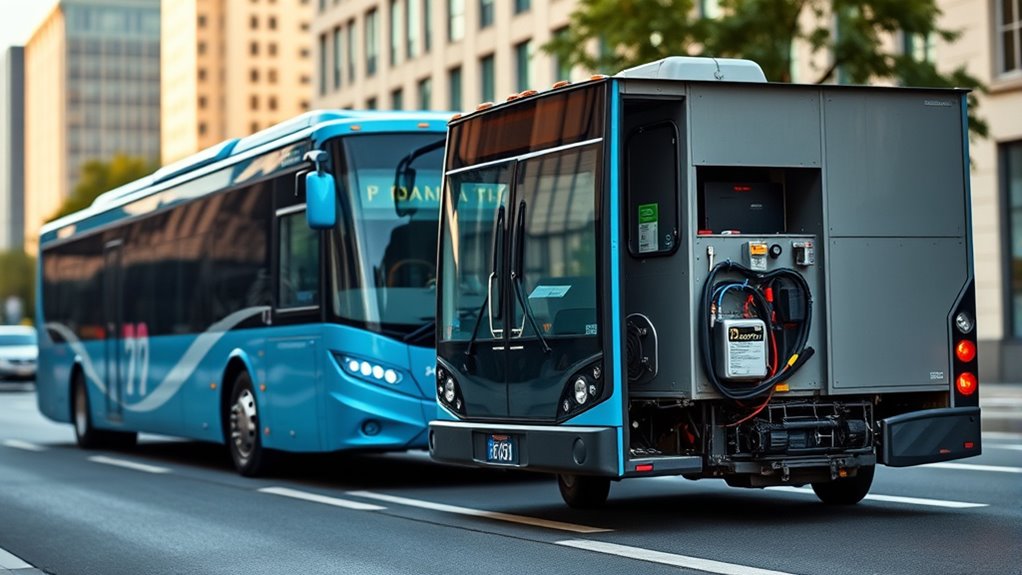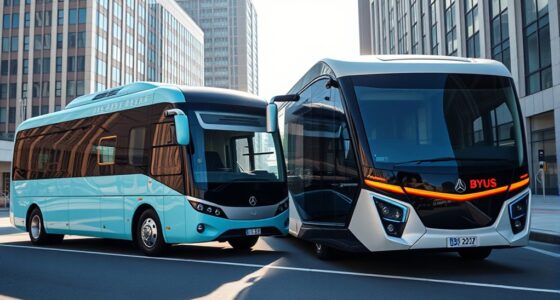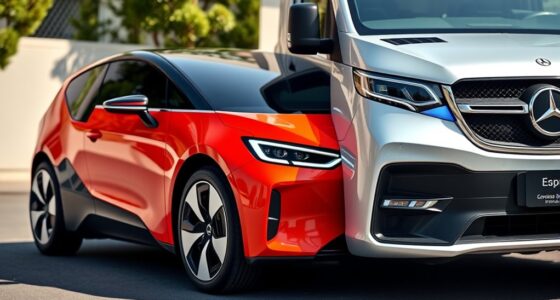Choosing between new and retrofitted electric buses depends on your goals and budget. Retrofitting allows you to upgrade existing diesel chassis, extending their lifespan and markedly reducing environmental impact at a lower cost than buying new buses. This approach supports urban mobility goals and minimizes downtime. If you’re interested in cost-effective, sustainable transit options without complete fleet replacement, you’ll find more insights ahead that could help shape your decision.
Key Takeaways
- Retrofitting extends existing diesel bus chassis lifespan cost-effectively compared to purchasing new electric buses.
- New electric buses offer modern designs, latest technology, and longer warranties but require higher upfront investment.
- Retrofitting involves upgrading batteries and systems, enabling quicker deployment with less disruption to current fleets.
- New buses are generally more optimized for range, charging, and efficiency, while retrofits depend on existing chassis capabilities.
- Strategic choice depends on budget, fleet size, infrastructure, and long-term sustainability goals.

As cities seek greener transportation options, upgrading diesel bus chassis to electric powertrains offers a practical and cost-effective solution. One of the key factors in successful retrofitting is understanding battery technology. Modern batteries, particularly lithium-ion variants, have seen significant improvements in energy density, lifespan, and charging speed. This means that a retrofitted electric bus can deliver a sufficient range for daily routes while maintaining reliability over many years. With advancements in battery technology, you no longer need to worry about frequent replacements or limited driving distances. Instead, you get a system that is efficient, durable, and capable of supporting intensive urban transit schedules. These batteries are also becoming more environmentally friendly, with many manufacturers focusing on reducing the carbon footprint of production and disposal, aligning well with the goal of cleaner transportation.
Equally important is the charging infrastructure. When upgrading diesel chassis to electric, you must consider where and how the buses will recharge. Installing fast chargers at depots or key transit hubs can significantly reduce downtime, allowing buses to quickly top up during off-peak hours. This infrastructure must be scalable and adaptable to future technological improvements. You want to guarantee that your charging stations support different power levels and connector types to accommodate various bus models and battery sizes. The integration of smart charging systems can optimize energy use, prevent overloads, and even leverage renewable energy sources, further reducing emissions. Planning for an effective charging infrastructure is essential because it directly impacts the operational efficiency and cost savings of your electric fleet. It’s not just about installing chargers but creating a holistic system that integrates seamlessly with your scheduling and maintenance routines.
Retrofitting buses with electric powertrains can be a smart move, especially when you leverage the latest battery tech and establish robust charging infrastructure. The upfront investment might seem substantial, but the long-term savings in fuel, maintenance, and emissions are compelling. Plus, with ongoing innovations in battery chemistry and charging technology, you’ll find that your electric fleet becomes more reliable and easier to operate over time. This approach allows you to extend the lifespan of existing bus chassis while upgrading their environmental performance. It’s a strategic way to transition toward cleaner urban mobility without the need for entirely new bus procurement. Ultimately, your choice of battery technology and charging infrastructure will determine how smoothly your fleet transitions into a sustainable future, improving air quality and reducing operational costs in the process.
Frequently Asked Questions
What Is the Typical Lifespan of an Upgraded Electric Bus Chassis?
You can expect your upgraded electric bus chassis to last around 12 to 15 years, depending on usage and maintenance. Battery longevity plays a key role, but with proper care, batteries can remain effective throughout this period. The chassis’s durability guarantees the bus stays reliable over time, even as technology advances. Regular inspections and maintenance help maximize lifespan, keeping your electric bus in good shape for many years.
How Does Retrofitting Impact the Warranty of the Original Diesel Chassis?
When you retrofit a diesel chassis, warranty implications can vary. For example, if your retrofit is certified under specific standards, the original warranty might remain intact or be partially preserved. However, without proper retrofit certification, manufacturers may void parts of the warranty due to modifications. Always check with the manufacturer to understand warranty implications before retrofitting, ensuring the process complies with warranty policies and preserves coverage.
Are There Any Specific Safety Regulations for Retrofitted Electric Buses?
You need to follow specific safety regulations for retrofitted electric buses, especially regarding battery safety and retrofit standards. These standards guarantee the battery systems are secure, prevent fire hazards, and meet industry safety benchmarks. Regulations may vary by region, but generally, you must comply with electrical safety codes and conduct rigorous testing. Staying updated on local retrofit standards helps you ensure your retrofitted bus is safe and compliant.
What Are the Long-Term Maintenance Costs Compared to New Electric Buses?
Oh, the joy of balancing maintenance costs! Retrofitted electric buses often rack up higher long-term expenses because their batteries might have a shorter lifespan, leading to early replacements. Plus, upgrading or expanding charging infrastructure adds to the budget. In contrast, new electric buses typically come with modern batteries and more efficient systems, reducing maintenance costs over time. So, don’t be surprised if retrofitted options feel like a never-ending money pit.
How Does Retrofitting Affect Vehicle Resale Value?
Retrofitting can lower your vehicle’s resale value because it might cause value depreciation in the resale market. Buyers may see retrofitted buses as less reliable or harder to resell, which affects their willingness to pay a premium. While retrofitting is environmentally friendly and cost-effective upfront, it can reduce your bus’s appeal and resale value later on, especially if the modifications are not professionally done or well-maintained.
Conclusion
Just like Icarus soaring too close to the sun, clinging to old diesel chassis can lead to costly setbacks. Upgrading to electric buses isn’t just a smart choice; it’s your chance to embrace a future where sustainability soars without limits. By retrofitting or choosing new electric models, you’re not just keeping up—you’re leading the charge into a cleaner, greener tomorrow. Don’t let the past hold you back; seize the opportunity before it’s gone.









